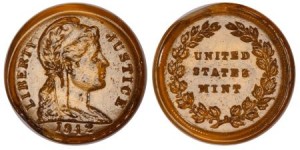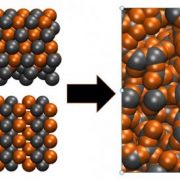Glass pennies?! Lost glass penny rediscovered
During World War II, the United States government was looking for ways to reduce the copper content of pennies, in order to make more copper available for the war effort. Copper was a rationed item, and in 1942, the War Production Board refused to allocate any copper to the US Mint for penny production for 1943.
That sent the US Mint looking for potential substitute materials. The Mint conducted its own experiments with metals and alloys, but also invited private companies to submit prospective replacements for the copper penny made from plastics and alternative materials. As part of the invitation, the Mint loaned specially crafted dies that were to be used by participating companies to produce the samples. The sample dies contained an impression of Liberty and the date for the obverse side, and a wreath with the words “United States Mint” on the reverse side.
The Blue Ridge Glass Company acquired a set of the dies and produced a very limited number of glass samples, using penny-sized tempered blanks created by Corning. The experiment didn’t work very well. To make a glass penny, both the die and the blank had to be heated to just below the melting point of glass. They weren’t able to heat the die properly, and they were only able to achieve soft detail on the glass blanks. In addition, the resulting glass “pennies” had a large number of surface imperfections.
The Blue Ridge Glass Company prepared a report for the US Mint, and that was the end of the glass penny. Only one known example of a glass penny existed, and it was broken in half. Recently, a second example, which is intact, was discovered and graded by the Professional Coin Grading Service. The intact example, which is owned by a private collector, is a virtually identical match to the known, broken coin.
Even without its obvious production flaws, the glass penny likely never would have made it to the production stage. The dimensions and weight of each penny could not be standardized, meaning that each penny would have been slightly different – a violation of the US Mint’s uniformity standards.
Glassprimer™ glass paint is a specialized glass coating that bonds permanently to glass surfaces. GlassPrimer also makes a glass surface molecular activator that is designed to work with UV-inkjet glass printing processes. For more information about Glassprimer™ glass paint, please visit the rest of our site. If you’d like to purchase Glassprimer™ glass paint, please visit our online store.
Photo Credit: Professional Coin Grading Service




